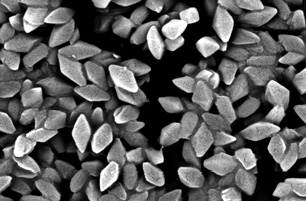Bacillus thuringiensis (Bt) and Cry Toxins

Cry protein crystals.
Bacillus thuringiensis (Bt) are a group of bacteria used as pesticides in agriculture, forestry, and mosquito control programs. They form a crystal protein (also known as a cry protein) that is toxic to certain insect species, including beetles, flies, mosquitoes, moths and butterflies.
Bt are generally considered harmless to animals and plants, and therefore an environmentally preferred pesticide treatment. Scientists have developed methods to genetically engineer the cry protein produced by the bacteria to create pesticidal crops that produce the toxin.
According to the EPA, due to the nonproliferation of Bt in water, “potential for drinking water exposure is negligible.”
Health Effects of Bacillus thuringiensis
Bacillus thuringiensis are considered harmless to mammals, but they may sometimes produce diarhea-inducing toxins normally associated with a similar bacterium, Bacillus cereus.
Water Treatment for Bacillus thuringiensis
Bacillus thuringiensis are not expected to proliferate in water, but they may be difficult to remove once there. According to a report by the EPA, they are similar in structure to Bacillus anthracis, the bacteria responsible for anthrax. Like B. anthracis, they can survive for years and are not quickly treated with chlorine, chloramines, a one-minute water boil, or UV light.
Sources: EPA, WHO, Wikipedia, Photo: WikiMedia, author: P.R.Johnston.
Site Index
Filtration Systems
- Aeration for Iron & Sulfide
- Backwashing Filters
(whole house & well units)
- Chlorine & Chemical Injectors
- Countertop Water Filters
- Garden Hose Filters
- Reverse Osmosis, Residential
- Reverse Osmosis, Commercial
- Shower Filters
- Specialty Filters
- Ultraviolet Systems
- Undersink Filters
- Water Softeners
- Whole House Filters
Cartridges
Parts
- Replacement Parts
- Faucets
- Filter Media
- Fittings
- Housings
- O-rings
- Pumps
- Pura UV
- R.O. Parts
- R.O. Tanks
- R.O. Booster Pump
- VIQUA UV